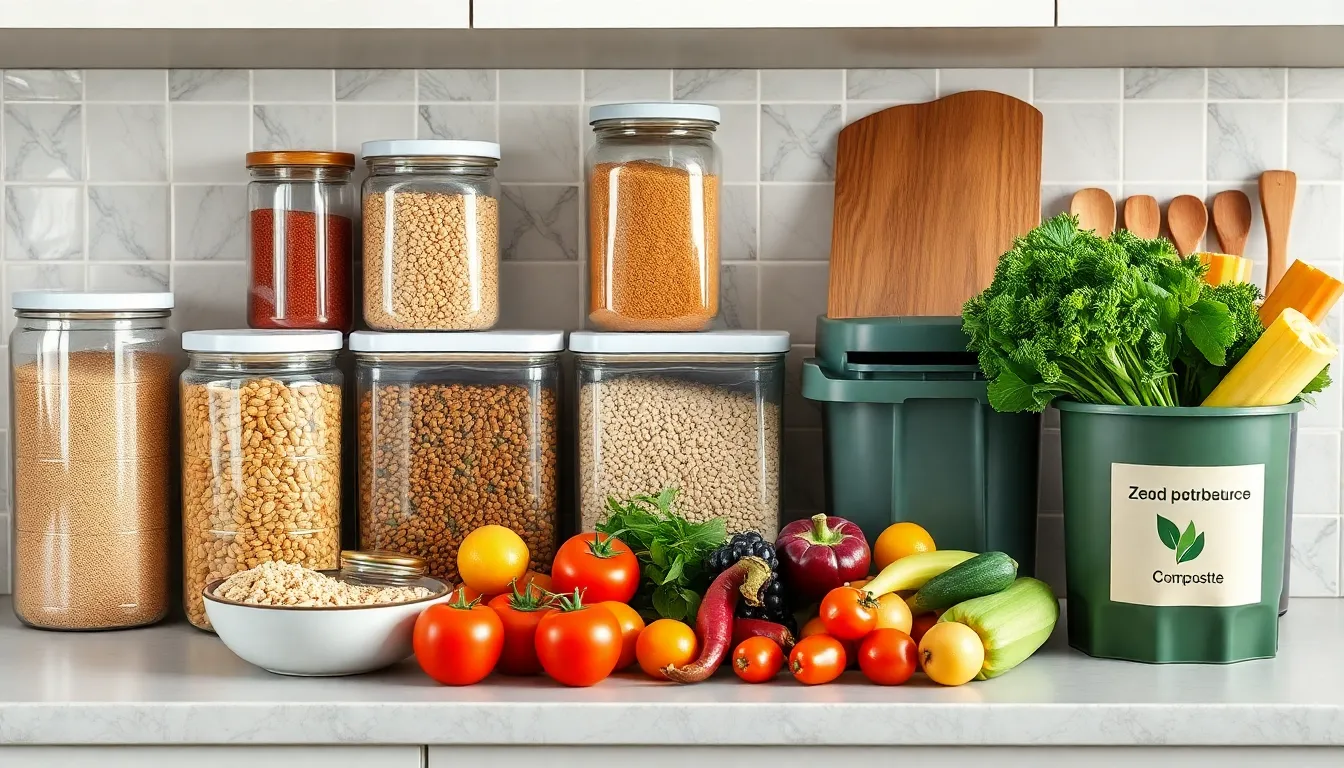Imagine a kitchen where every scrap of food and every single item has a purpose. A zero waste kitchen isn’t just a trend; it’s a lifestyle that turns waste into a thing of the past. With a sprinkle of creativity and a dash of resourcefulness, anyone can transform their cooking space into an eco-friendly haven.
Table of Contents
ToggleWhat Is a Zero Waste Kitchen?
A zero waste kitchen creates an environment that minimizes waste through thoughtful practices. This approach emphasizes the use of reusable containers, cloth napkins, and bulk ingredients, reducing reliance on single-use items. By incorporating composting, leftover management, and mindful shopping, individuals can significantly lower their kitchen waste output.
Many aspects contribute to a zero waste kitchen. First, utilizing glass jars or stainless steel containers for storage eliminates the need for plastic wrap. Second, opting for local and seasonal produce enhances freshness while cutting down on packaging waste. Shopping at bulk stores allows for purchasing only necessary quantities, further diminishing excess.
Repurposing and upcycling are vital components. Vegetable scraps can be transformed into broth, and stale bread can become croutons. Embracing creativity not only reduces waste but also adds variety to meals.
Staying organized plays a key role in a zero waste kitchen. Labeling jars and containers helps individuals track what they have on hand, reducing impulse purchases. Regular meal planning ensures that ingredients are used efficiently, preventing spoilage.
Lastly, educating oneself about sustainable practices strengthens their zero waste efforts. Following eco-friendly blogs, joining local community groups, and attending workshops provide valuable insights. Engaging with like-minded individuals fosters a shared commitment to a more sustainable lifestyle.
Benefits of a Zero Waste Kitchen

A zero waste kitchen offers significant advantages that resonate with both environmental concerns and personal finances. Understanding these benefits fosters a stronger commitment to sustainable practices.
Environmental Impact
Reducing kitchen waste positively impacts the environment. For instance, landfills contribute 18% of total greenhouse gas emissions, primarily from decaying organic matter. A zero waste kitchen minimizes this effect by diverting food scraps from landfills through composting. Furthermore, using bulk ingredients lowers energy consumption associated with packaging production and disposal. Dining on local, seasonal produce supports regional ecosystems and diminishes the carbon footprint associated with transportation. As waste decreases, so does the strain on natural resources, promoting a healthier planet for future generations.
Financial Savings
Financial benefits of a zero waste kitchen are substantial. Individuals save money by purchasing bulk items, avoiding overpriced packaging. Emphasizing meal planning reduces impulse buying and food spoilage, ensuring all ingredients get used. Repurposing leftovers into new meals cuts grocery expenses while diversifying daily menus. Investing in reusable containers pays off long-term by replacing single-use items, leading to reduced waste and savings. A focus on this sustainable lifestyle transforms not only the kitchen but also the household budget.
Key Principles of Zero Waste Living
Zero waste living focuses on intentional practices and principles that minimize waste. Embracing these principles can significantly transform kitchen habits.
Refuse
Refusing unnecessary items plays a crucial role in zero waste living. Opting out of freebies, single-use plastics, and excessive packaging can dramatically reduce waste. Consumers encourage businesses to adopt eco-friendly practices by rejecting items that contribute to waste. One simple action involves carrying reusable bags and containers to avoid defaulting to disposable options.
Reduce
Reducing consumption significantly cuts waste. Kitchen staples, such as purchasing only what is necessary, help to minimize excess. By planning meals and creating shopping lists, individuals can avoid impulse buys. Choosing products with less packaging and opting for bulk items allows for lower waste generation. Prioritizing quality over quantity, where possible, leads to fewer replacements and less clutter.
Reuse
Reusing items can prolong their life and minimize waste accumulation. Glass jars, old containers, and cloth napkins serve various purposes in a zero waste kitchen. Creative repurposing of food containers for storage or using old towels as rags exemplifies this practice. Many people find joy in discovering new ways to use items rather than discarding them. The more versatile objects are, the less likely they’ll become waste.
Recycle
Recycling should supplement the first three principles, not replace them. Sorting recyclables properly allows materials to be processed effectively and reduces landfill contributions. Familiarizing oneself with local recycling guidelines maximizes recycling efforts. Many communities offer resources to help residents understand proper recycling practices. Recycled materials, when processed correctly, can reintegrate into the supply chain and reduce the need for virgin resources.
Rot
Composting food scraps and organic waste closes the loop and nurtures the earth. Kitchen waste, such as vegetable peels and coffee grounds, can transform into nutrient-rich compost. Many cities offer composting programs that aid in reducing landfill waste while improving soil quality. Those with gardens benefit directly from using homemade compost for enriching their plants. Embracing this practice creates a sustainable cycle that positively impacts the environment.
Practical Tips for Achieving a Zero Waste Kitchen
Creating a zero waste kitchen requires intentional habits and strategies. Adopting mindful shopping and effective storage solutions greatly contributes to this sustainable lifestyle.
Smart Shopping Habits
Purchase in bulk to minimize packaging waste. Look for local farmers’ markets that offer fresh produce without excess wrapping. Choose reusable bags for grocery shopping to avoid single-use plastic. Select products with minimal or no packaging whenever possible. When planning meals, make a shopping list to ensure only necessary items are bought. Avoid impulse buys that often lead to discarded food. Opt for seasonal ingredients; they’re not only fresher but also more eco-friendly. Supporting local businesses can strengthen community ties while reducing transportation emissions.
Creative Storage Solutions
Use glass jars for dry goods. They not only reduce plastic usage but also make it easy to see contents. Transform old containers into storage solutions rather than discarding them. Consider using beeswax wraps as a sustainable alternative to plastic wrap. Label jars to streamline organization and prevent food waste from confusion about contents. Implement a system for rotating food items, ensuring older items get used first. Invest in cloth or mesh bags for produce to further cut down on plastic. Seek airtight containers to maintain freshness, reducing spoilage and undesirable waste.
Challenges and Solutions
Implementing a zero waste kitchen presents specific challenges. Understanding common obstacles helps in effectively addressing them.
Common Obstacles
Limited knowledge often hinders progress. Many individuals aren’t aware of the full extent of waste produced in a kitchen. Forgetting to plan meals leads to unintentional food spoilage. Storage options can also restrict choices; inadequate containers often result in using non-reusable items. Additionally, convenience frequently trumps sustainability. Many consumers gravitate toward pre-packaged foods, inadvertently increasing waste. Committing to change requires persistent efforts to counter these obstacles.
Overcoming Waste Mindsets
Changing attitudes toward waste is vital for progress. Acknowledging the impact of waste on the environment fosters a sense of responsibility. Embracing a mindset of reusability encourages creativity when finding alternative solutions. Engaging with community groups increases accountability; shared experiences motivate adherence to zero waste principles. Prioritizing education helps individuals make informed decisions regarding sustainable practices. Developing habits such as meal planning and efficient storage can significantly reduce waste. Taking these steps empowers individuals to maintain a zero waste kitchen.
Transforming a kitchen into a zero waste space is a rewarding journey that benefits both the environment and personal finances. By embracing mindful shopping practices and utilizing creative storage solutions, individuals can significantly reduce their waste output.
Every small step taken towards minimizing waste contributes to a larger movement for sustainability. Engaging with community resources and adopting intentional habits fosters a sense of responsibility and accountability.
Ultimately, a zero waste kitchen isn’t just about reducing garbage; it’s about cultivating a lifestyle that values resourcefulness and environmental stewardship. With dedication and creativity, anyone can create a kitchen that reflects these principles while enjoying the many rewards that come with it.



